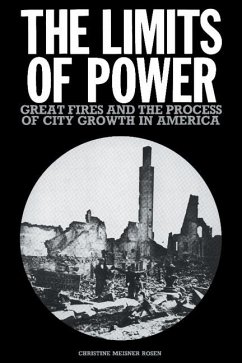This book examines the rebuildings of Chicago, Boston, and Baltimore following great fires.
Chicago, Boston, and Baltimore all suffered terrible fires in the late nineteenth or early twentieth century. Residents of these cities agreed that the destruction caused by the fires provided them with a special opportunity to improve their inadequately built cities. This book examines these rebuildings, using each to examine in close detail the process of city growth. The massive population growth and economic expansion of the nineteenth century necessitated that every aspect of the urban environment be redeveloped. Yet, at virtually every stage of city growth, the achievement of environmental adaptation lagged significantly behind the need for change. The innovative features of this book will make it useful to all readers interested in city growth. By drawing on several fields of the social sciences, the author develops a conceptual framework for explaining the barriers to environmental improvement; and through the historical narrative, the usefulness of this framework is demonstrated.
Table of content:
List of figures and tables; Acknowledgments; Part I. The Conceptual Framework: 1. Introduction; 2. The barriers to structural improvement; 3. The barriers to infrastructural improvement; 4. The barriers to spatial change; Part II. Three Case Studies: 5. Theory and narrative history; 6. The rebuilding of Chicago; 7. The rebuilding of Boston; 8. The rebuilding of Baltimore; Part III. Conclusion: 9. Power in the city; Notes; Sources of illustrations; Index.
Hinweis: Dieser Artikel kann nur an eine deutsche Lieferadresse ausgeliefert werden.
Chicago, Boston, and Baltimore all suffered terrible fires in the late nineteenth or early twentieth century. Residents of these cities agreed that the destruction caused by the fires provided them with a special opportunity to improve their inadequately built cities. This book examines these rebuildings, using each to examine in close detail the process of city growth. The massive population growth and economic expansion of the nineteenth century necessitated that every aspect of the urban environment be redeveloped. Yet, at virtually every stage of city growth, the achievement of environmental adaptation lagged significantly behind the need for change. The innovative features of this book will make it useful to all readers interested in city growth. By drawing on several fields of the social sciences, the author develops a conceptual framework for explaining the barriers to environmental improvement; and through the historical narrative, the usefulness of this framework is demonstrated.
Table of content:
List of figures and tables; Acknowledgments; Part I. The Conceptual Framework: 1. Introduction; 2. The barriers to structural improvement; 3. The barriers to infrastructural improvement; 4. The barriers to spatial change; Part II. Three Case Studies: 5. Theory and narrative history; 6. The rebuilding of Chicago; 7. The rebuilding of Boston; 8. The rebuilding of Baltimore; Part III. Conclusion: 9. Power in the city; Notes; Sources of illustrations; Index.
Hinweis: Dieser Artikel kann nur an eine deutsche Lieferadresse ausgeliefert werden.








